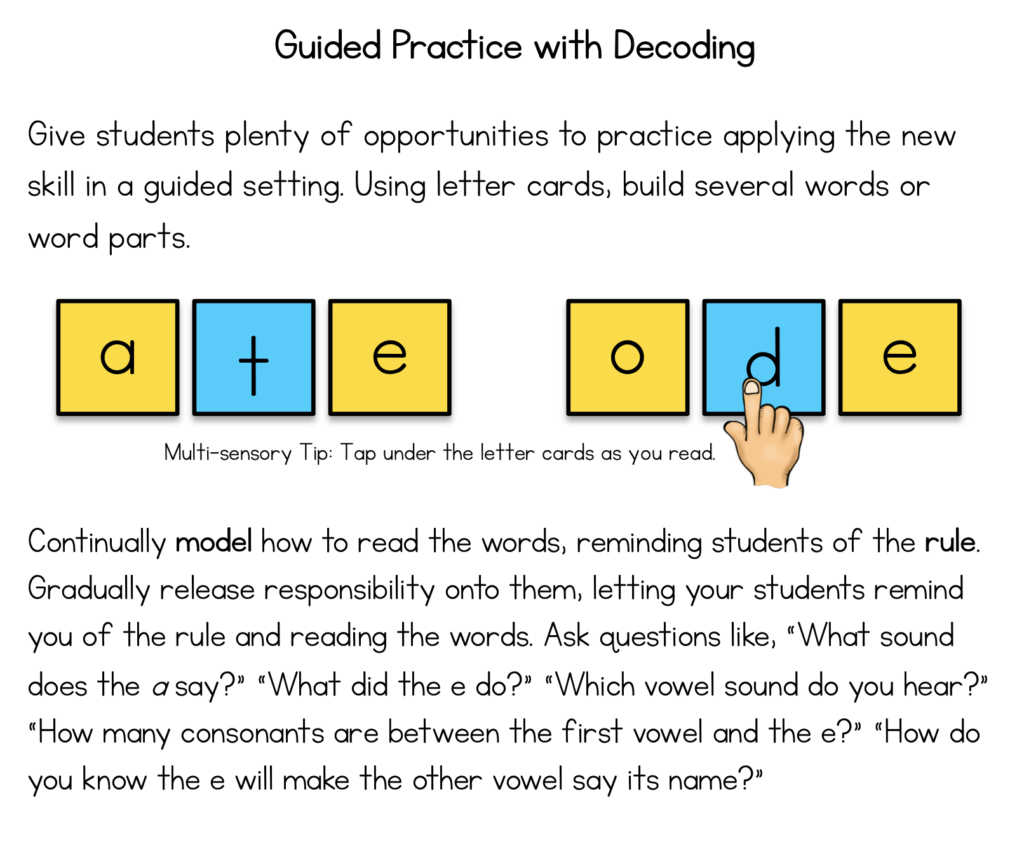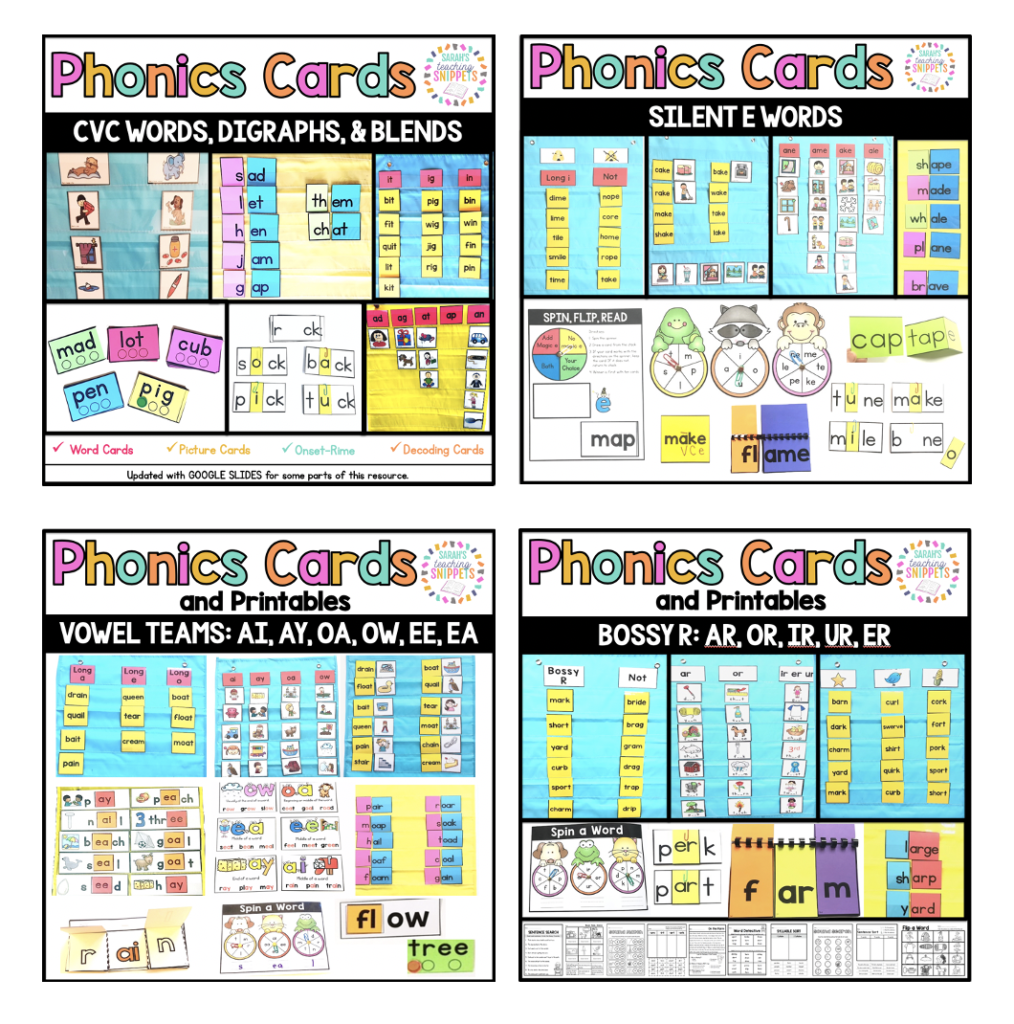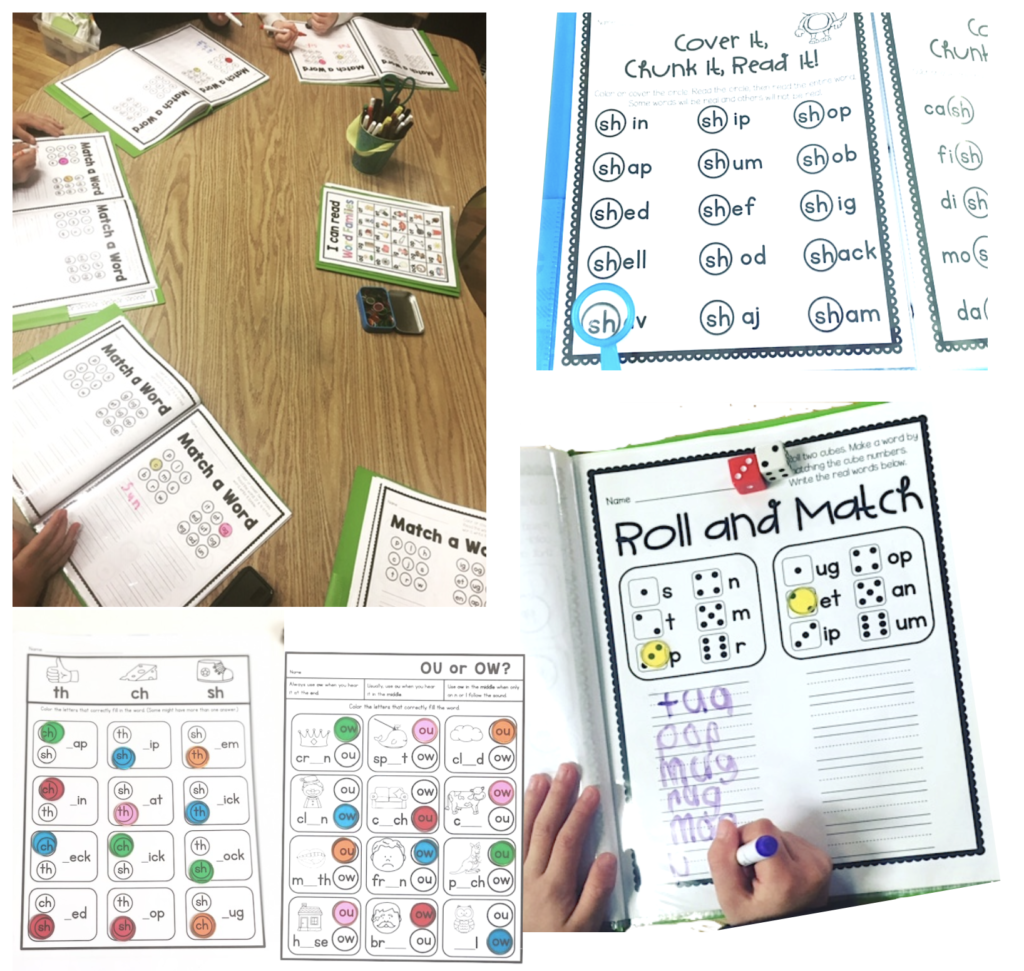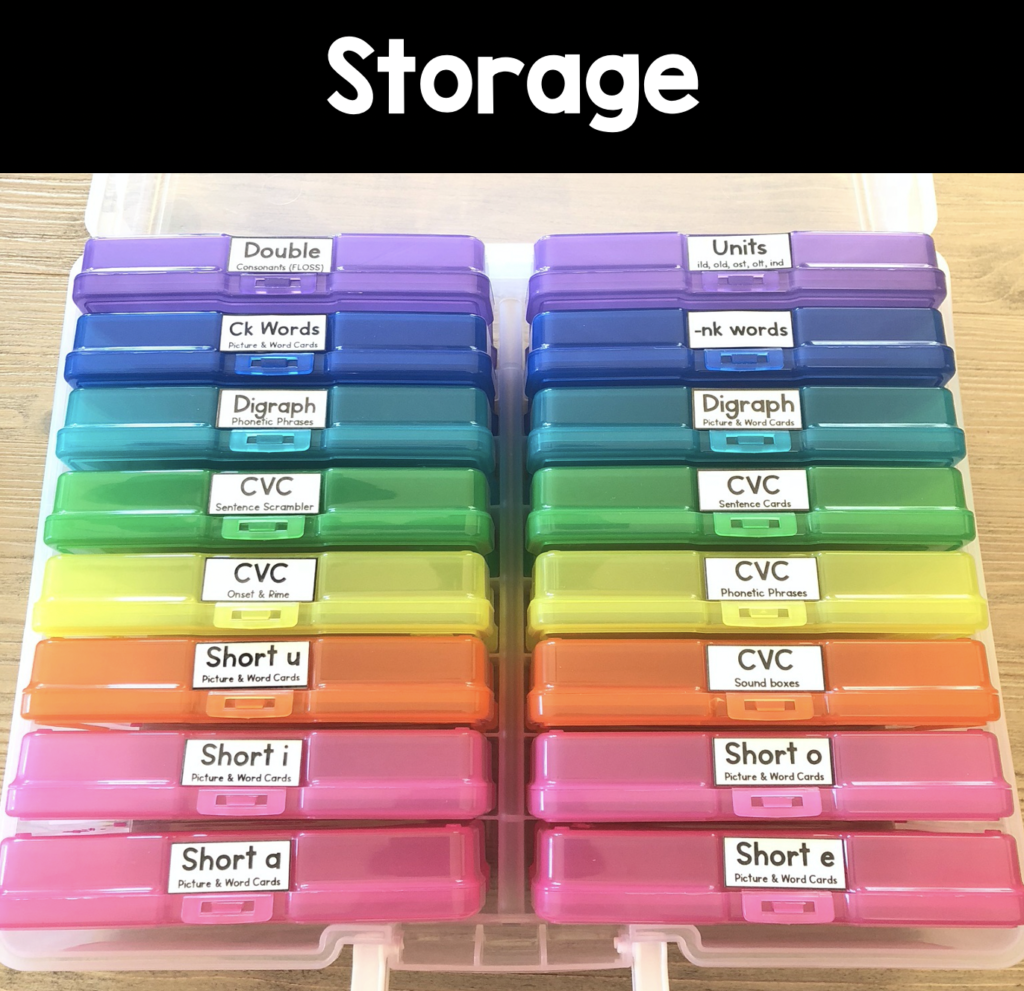After teaching first grade, I transitioned into a new role doing reading intervention. I absolutely. love. this. job. One thing I’ve really improved upon after taking this job is my phonics instruction. This post is really about reading intervention, but I titled it phonics intervention because so much of what I do for my students revolves around word study.
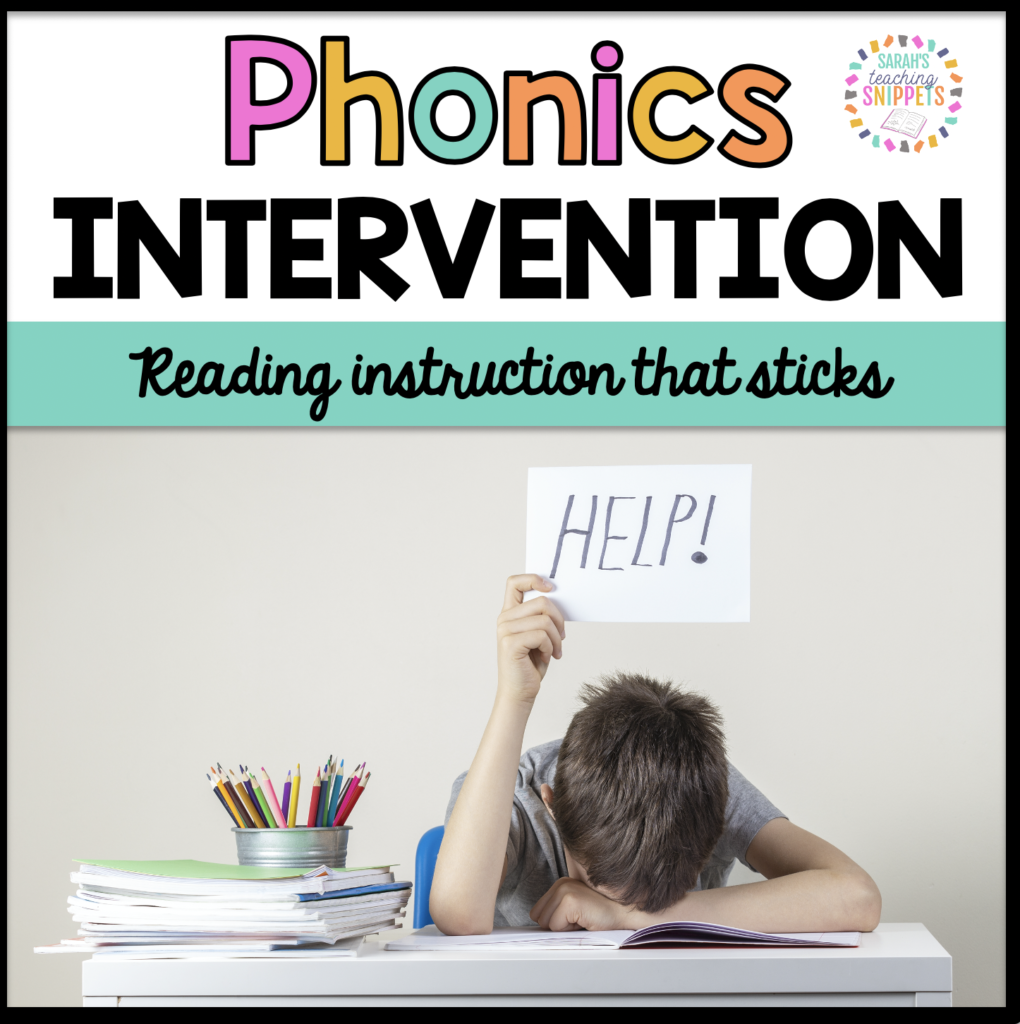
As you probably know, phonics is an essential component of reading instruction. It is especially important in the beginning stages of learning to read and is even more important with your students who are struggling with reading. The National Reading Panel determined that effective reading instruction includes a mixture of phonemic awareness, phonics, guided oral reading, and comprehension strategies.
By increasing the time I spend on phonics instruction (vs. sight word flash cards and leveled readers), I have watched my struggling readers make greater gains and feel more confident with reading. I still do plenty of other literacy-related instruction and activities, but I now make a conscious effort to include good phonics instruction daily. So what is good phonics instruction? These principals guide my teaching.
Good Phonics Intervention is…
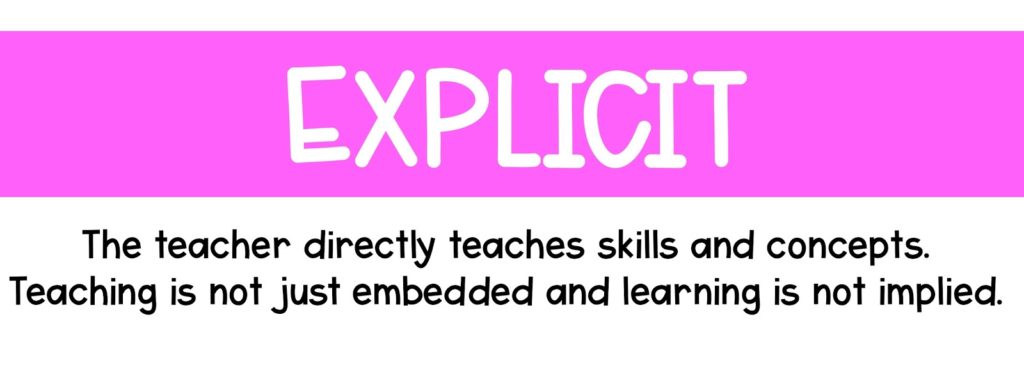
This. is. key. Many of our students can pick up phonics skills through guided reading and shared reading where the phonics skills are taught implicitly in context. BUT a significant percentage cannot. Many students need direct, explicit instruction with each phonics skill.
Now I know phonics has a bad rap for being “boring”, but it doesn’t have to be. I like to think that this more explicit intervention will lead to more fun, engaging reading instruction once a strong foundation has been set.
With all of that said, reinforcing phonics concepts in context is absolutely beneficial! Applying phonics skills in context shows kids why they should learn those letters and sounds in the first place. It is always important to provide that real-life application. So, to sum up, explicit phonics instruction is essential for our struggling readers, but implicit (embedded) phonics instruction can play a supporting role.

I admit it. I used to be all. over. the place. I learned that I need to be a bit more systematic with the way I teach these kids. There is science behind this! We are literally rewiring some of these kids’ brains. We are forming new pathways that need repetition to really be set. The more systematic and consistent we are with our instruction and the way we introduce and practice, the more likely our students will remember.
To see my systematic units, click here.
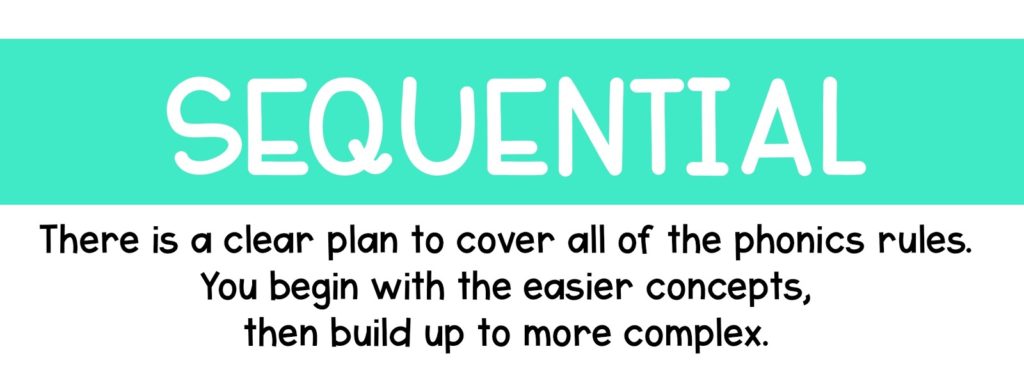
This was something I did not understand before. I thought, What does it matter? I’m teaching all the skills at some point! Looking back, I realize by not having a step by step roadmap for where I was going, I was leaving some stuff out and not teaching other things. More than that, I wasn’t giving my new or struggling readers the opportunity to be successful by giving them texts and word work using only phonetic elements that they have been taught.
For example, I begin with CVC words, then teach digraphs sh, th, and ch. Next I go into consonant blends and so on. This means that when we are working on consonant blends, I am not asking my students to read or spell words that have consonant blends with long vowels or r-controlled vowels because I haven’t taught that yet!
This is also super important. Have a roadmap to make sure you cover what you need to. You want to make sure you have formally taught these phonics concepts to your intervention students.
If your program doesn’t have a sequence for you, there are several to choose from, that are very similar. If you would like to see the phonics sequence I use, click here. I even have a specific sequence for my alphabet instruction. You can read more about my alphabet sequence here.
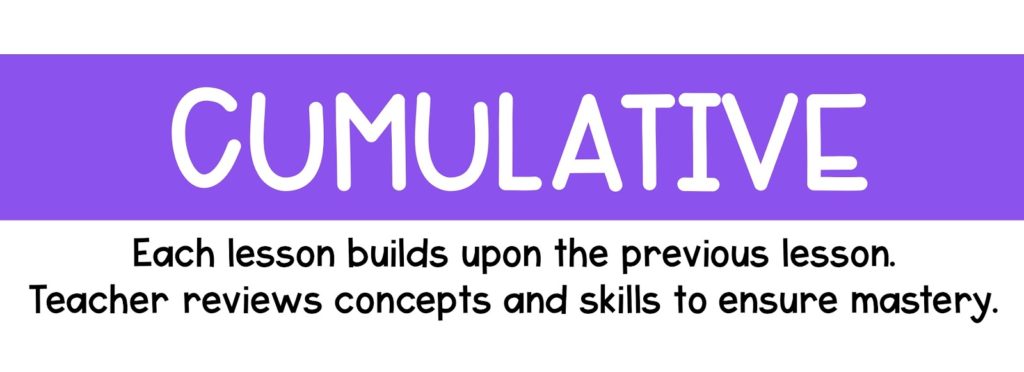
Good phonics intervention involves reviewing the skills you have previously taught. For example, when I am teaching short i, I make sure to review and practice short a because that lesson came right before and I know my students will need that review.
Our students need to revisit the lessons they’ve learned several times before they have reached mastery. As I mentioned above, this also means you don’t throw in things that they haven’t learned. For example, if I was teaching the digraphs sh, ch, and th, I wouldn’t include words like shark, beach, and think when practicing decoding because we haven’t learned ar, ea, or ink rules yet!
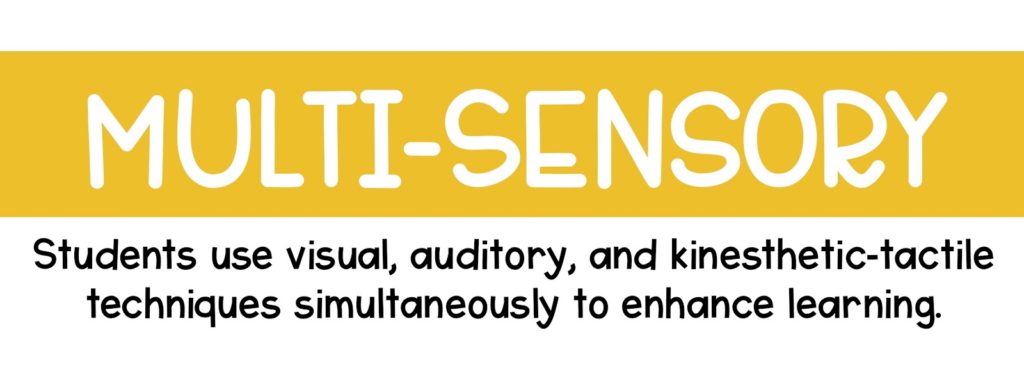
Multisensory learning involves the use of visual, auditory, and kinesthetic-tactile pathways simultaneously to enhance memory and learning of written language. International Dyslexia Association (IDA)
Heidi Songs has a FABULOUS post about multi-sensory teaching. You can read it HERE. I highly recommend using her music in your classroom. Your kids will be singing and moving to enhance their learning!
Multi-sensory teaching doesn’t have to involve play dough and sand as I once believed (although those are great tactile techniques.) You just need to make an effort to check yourself:
- Are your students using auditory and visual modalities?
- Are movement or tactile techniques incorporated in some way?
- This can be as basic as “tapping” the sounds of a word (tapping a finger on the table as you say each sound.)
- Simply saying a word and writing it as you sound out each sound is technically multi-sensory.
- Tracing a word on the table while saying the sounds of the letters you are writing is a simple way to use more than one of the senses.
Once you get in the habit of multi-sensory teaching, then you can add in all that other fun stuff (play dough, sand, foam texture sheets, etc.)
What does Phonics Intervention Look Like?
If you have a student with dyslexia in your class (and you probably do because 1 in 5 students has dyslexia to some degree), this is the type of instruction that is recommended. It is much more than phonics though! This post focuses on the phonics part of it, but if you want to read about the recommended instruction for students with dyslexia (beneficial for everyone actually), click here to read my post about Structured Literacy.
You may or may not have a program you are already using. The key is to make sure your instruction involves what I listed above for your intervention students. If you have a phonics program, it probably has a scope and sequence. Make sure you are introducing it at a rate that your struggling readers can keep up with. These kids will most likely need more time with each new phonics skill in order to master it. Once introduced, they need time to practice and then also time to review it each day before you are sure they have mastered that skill. You can teach a new skill when they have a grasp on the previous skill, but not quite to automaticity. You can move on from review once they have reached automaticity with reading words with that skill.
Below is what thorough phonics intervention looks like for me:
Since this post is about phonics instruction, I am beginning at the phase where students have developed phonemic awareness and know most of their letters and sounds. They are in the beginning stages of learning to read. All students benefit from explicit and systematic instruction, but struggling readers must have it. So I’ve laid out step by step what these kiddos need for reading instruction.
Phonics Intervention Steps 1 & 2: “Warm Up”
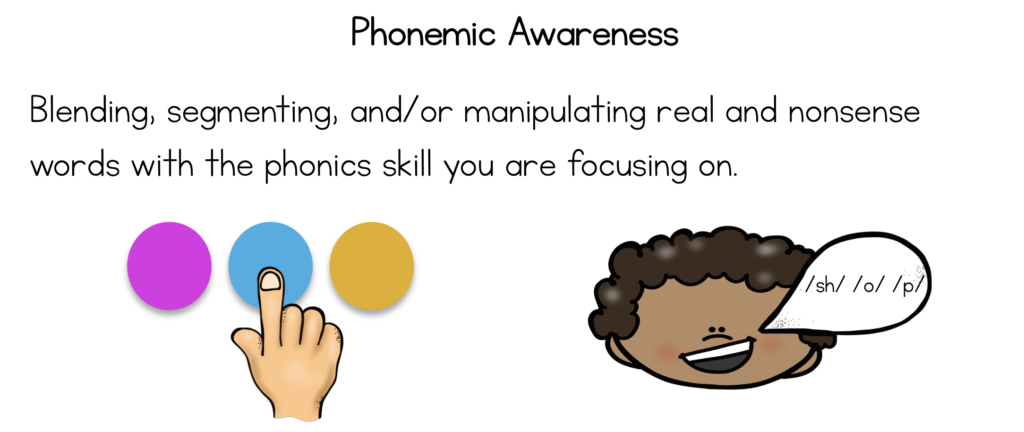
Phonemic Awareness
Phonemic awareness drills are usually short, but very effective. You can go big or you can do little to no prep, but they are essential to phonics intervention.
No prep phoneme segmenting drills involve the teacher giving students a word orally. Students repeat the word, then segment the sounds (phonemes).
It is best to use some sort of manipulative, like pictured below. For example, the teacher says, “shop”. The student(s) repeat it then say, “/sh/ /o/ /p/” as they push one of the manipulatives to represent each sound.
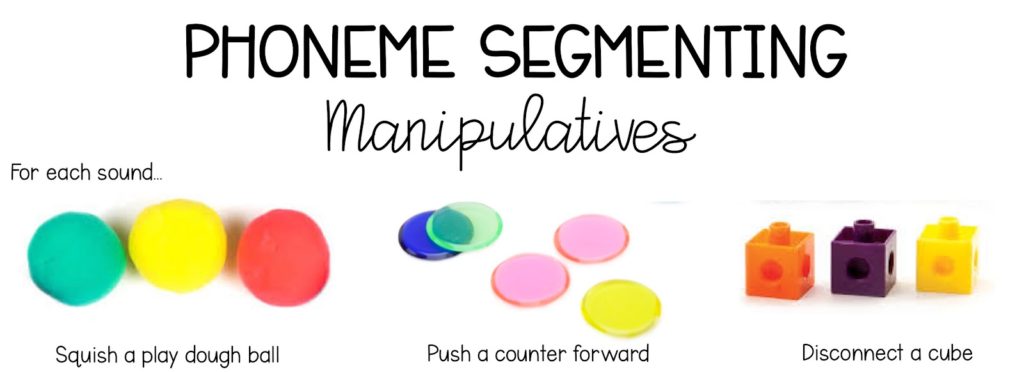
For phoneme blending, do the opposite. Teacher says the individual phonemes in a word, then have your student(s) repeat and guess your word. I do this with a puppet and the kids LOVE it! I tell them they need to help me translate what the puppet is trying to say.
When students are ready, you can take it a step forward and do phoneme manipulation (delete, add, or substitute a sound).
- After segmenting shop, ask: “What color was the sound /o/?” Students will point to the middle manipulative.
- Then ask: “What would the word be if this was /i/?” (ship).
- As they get better at it, you can take away the manipulatives and say, “Take the /l/ out of “slip”. What is left?” (sip)
Visuals are always helpful and also it’s nice to shake things up a bit with kids. If you are looking for more activities for phonemic awareness, click HERE.
Sound-Symbol Drills
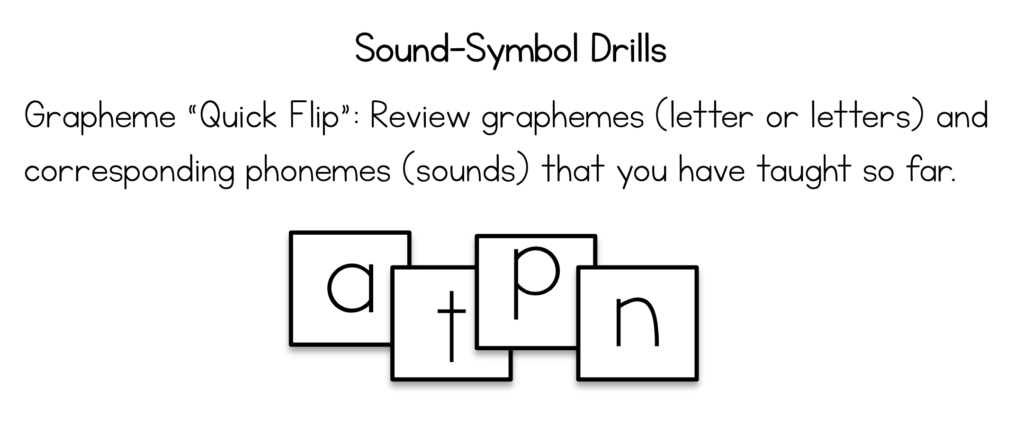
Graphemes are the letter or letters that represent sounds.
This quick review was something I never used to do, but now I see its importance with our struggling readers. Developing automaticity at the letter level is SO important. I have a post that goes more into automaticity HERE. The goal is not just to have our students know their letters, but to also automatically recognize them and produce the appropriate sound.
- This can be as basic as sound-symbol flashcards to flip through.
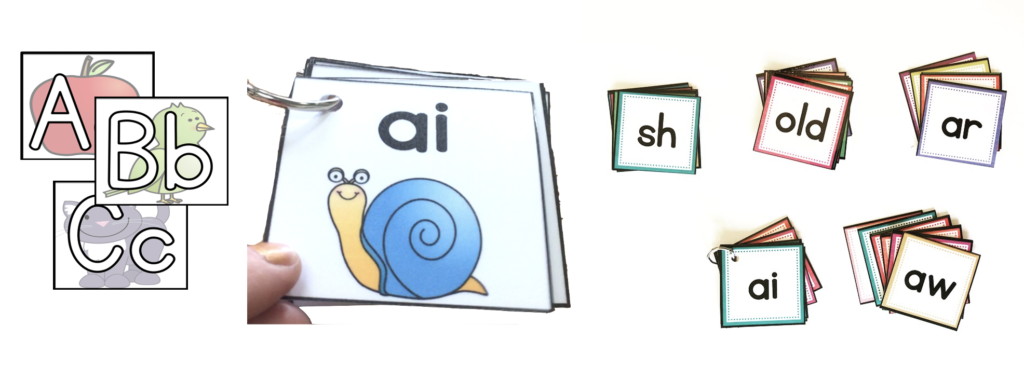
- I’ve also used these activities letter- sound drills:
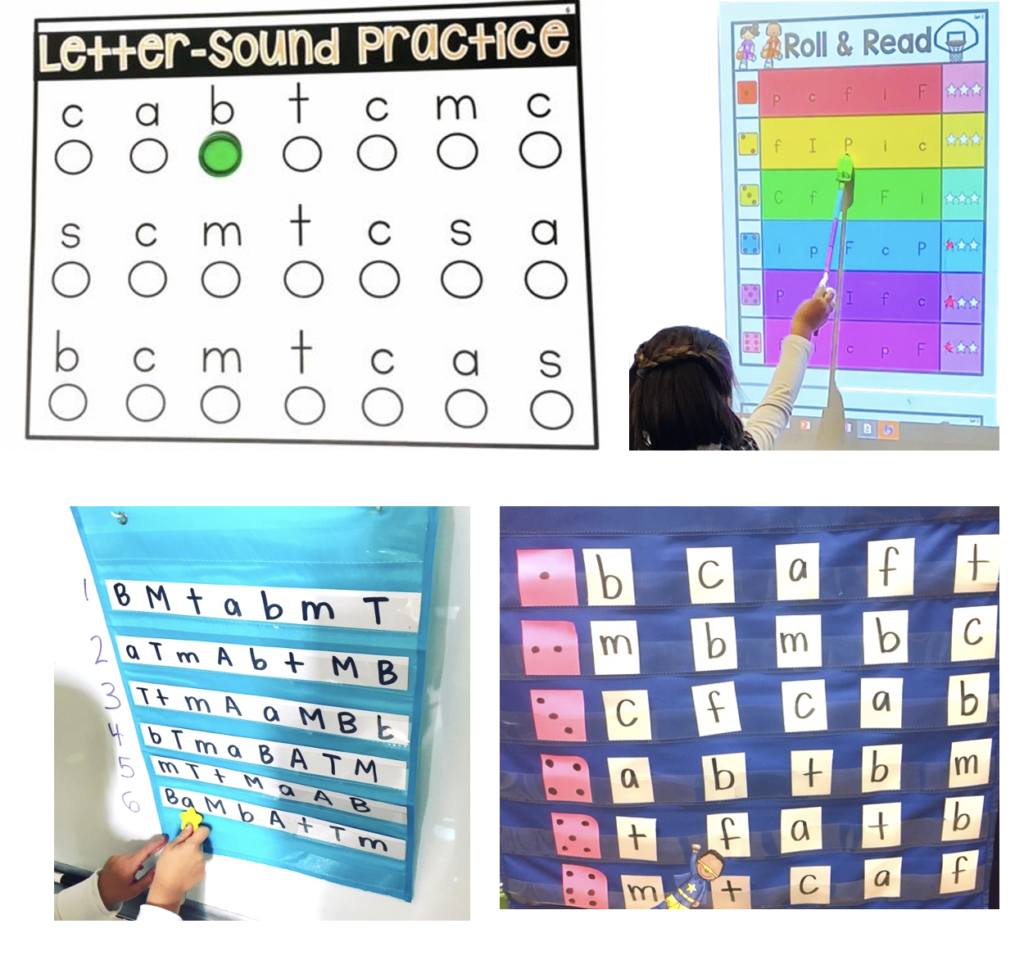
Top left Picture: You can do this as a group or each student can have their own page to practice. Spend 1-2 minutes sliding the circular chip across the page while saying the sound that goes with each letter. You can find these letter automaticity drills here.
These other three pictures show the same activity that I’ve done at different times with a small group or a whole class. Put the letters in a pocket chart or write on chart paper randomly. Point to the letters and students quickly give the sounds. Make it a game by adding a die. (Roll the die. Read the row with the number you land on.) The picture from the top right is from this file.
The pictures above show letters of the alphabet, but you can do the same with digraphs, vowel teams, r-controlled vowels, consonant blends, and even rimes (word endings). Since it’s a “warm up”, it is meant to be done quickly, but it is very effective. For free grapheme flashcards, click here.
I also do a warm-up drill that focuses on rimes (word ending). The picture below show a quick automaticity drill that I do to review.
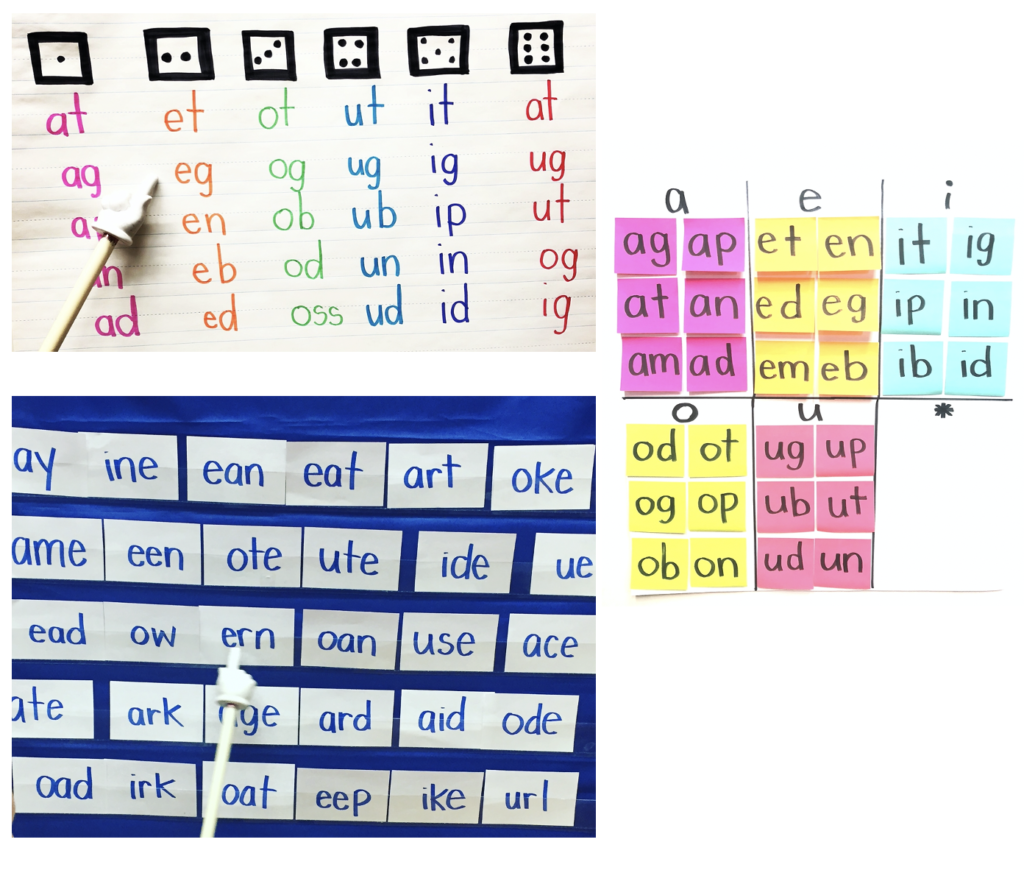
Phonics Intervention Step 3: Connect to Pronunciation
I recently learned that it is best to begin with the auditory then move to the print. Beginning with sound allows for your students to connect the unknown (the letter combination) to the something familiar (the oral pronunciation).
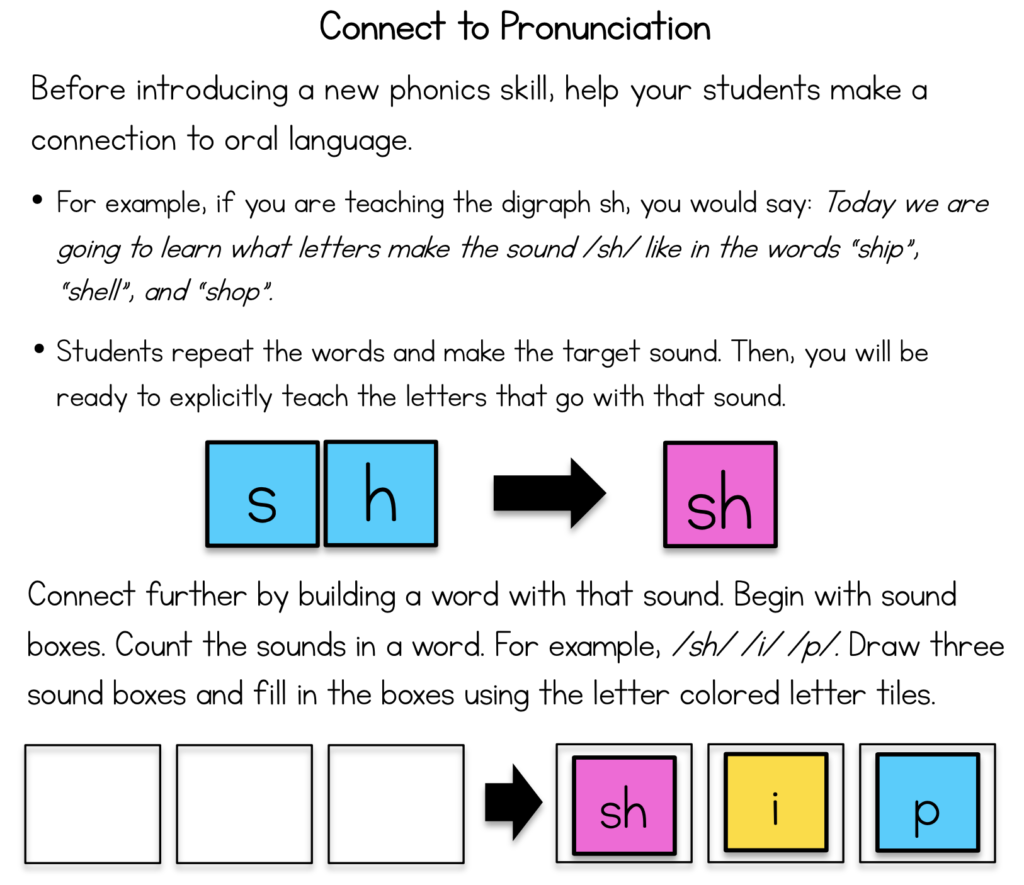
After practicing a few more familiar words this way, then you can transition to the opposite, which is building a word for your students to read. This way they can apply their new knowledge.
Phonics Intervention Step 4: Explicitly Teach Skill or Concept
This is the part where you are sure to directly teach your students what you want to teach them.
- With the digraph example, the direct teaching is that to make the sound /sh/, you use the letters s and h together.
- If you’re teaching silent e, the direct teaching is that usually when they see the letter pattern vowel-consonant-e, the letter e is silent and the first vowel makes its long sound.
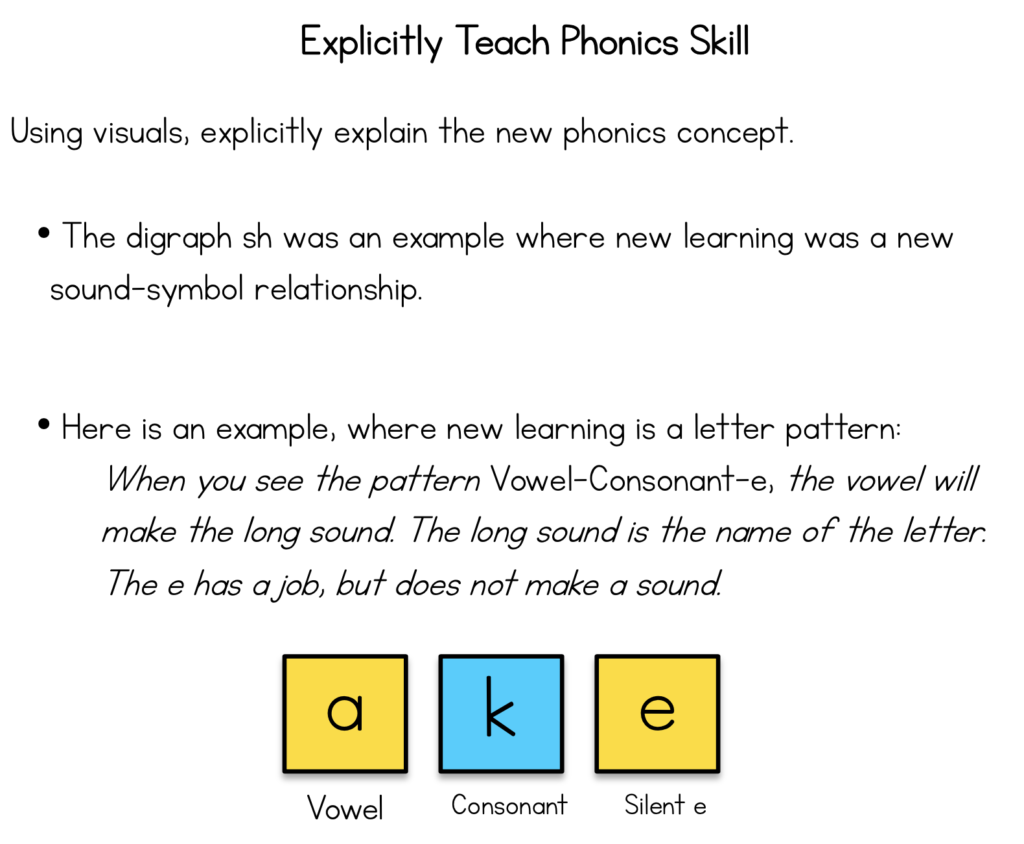
Visual reminders can be so helpful with phonics intervention. For example, when I teach short vowels, I have a key picture/word for each vowel. I teach each vowel sound one at a time (systematic and sequentially) and review the previously learned vowels before teaching a new one (cumulative). Below is the visual I use for my short vowels. When a student forgets what one of the vowels say, I point to the chart and have them say the key word. This leads them to the sound. For example, “igloo, iiiigloo, /i/”.

Phonics Intervention Step 5: Model Decoding
In the beginning, I model decoding using the color-coordinated letter tiles. In the picture below, I’ve shown a few ways you can do this.
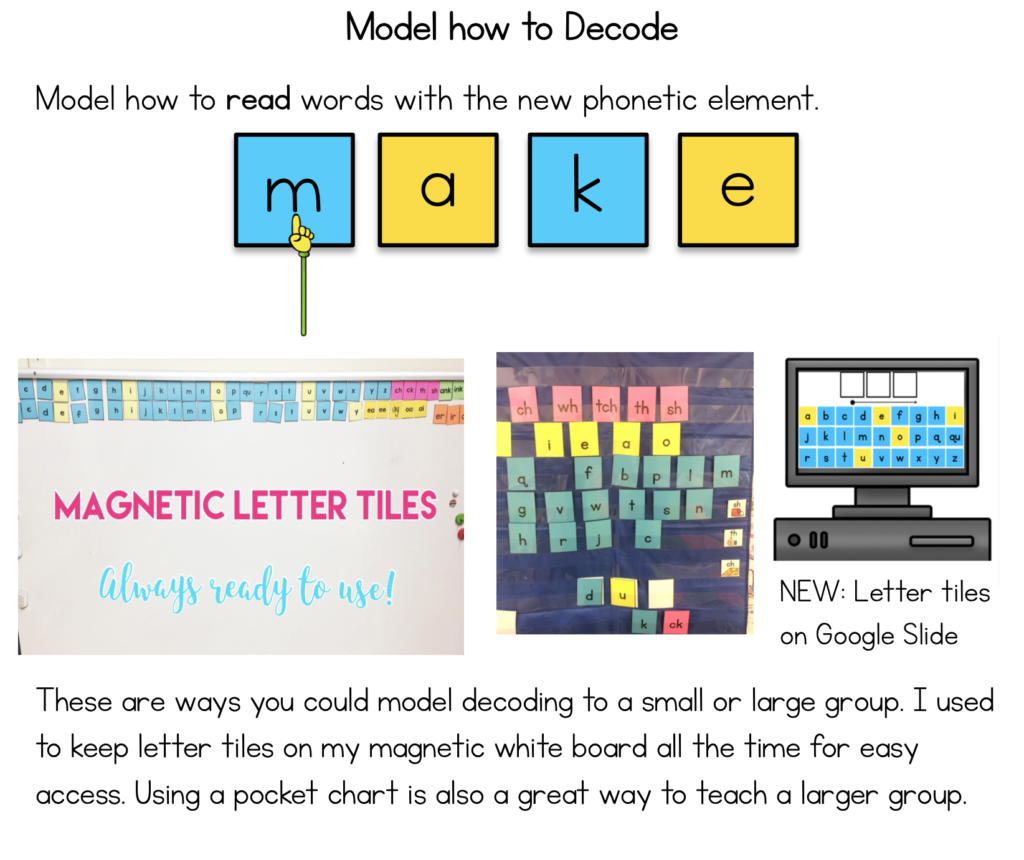
- If you have a magnetic white board in your small group area, you can place your small letter cards with magnetic dots on the top or bottom of your white board. That way you can use them when you need to model and build words.
- You can also use a pocket chart. I have this mini pocket chart that I got at Target years ago and it’s perfect.
- Update: I recently added Google Slides to my free letter tiles.
If you need letter cards to print out, you can use THESE FREE letter cards:
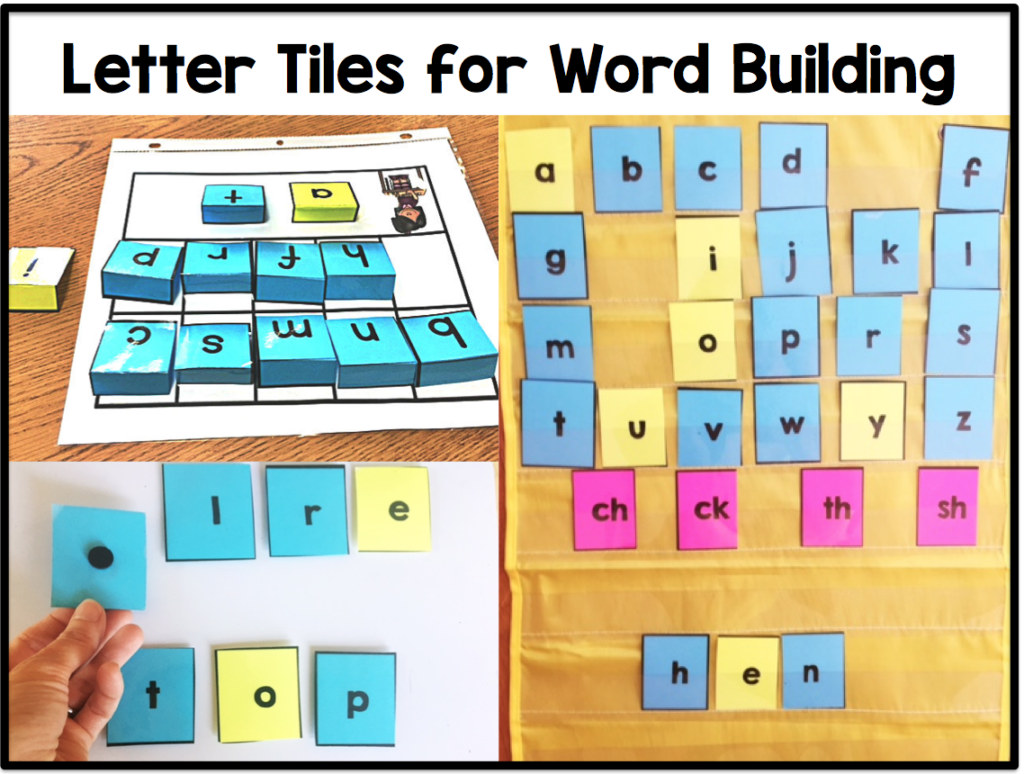
These letter cards help your instruction to be more explicit for your students. The colors are great for showing consonants and vowels and then digraphs.
Phonics Intervention Step 6: Guided Practice with Decoding
I do this with my students every day. When we are first practicing a new skill, I build and read more words with letter tiles. Then, as they learn the skill, I do less with the letter tiles and more practice in other ways (see below.) I find that building words with letter tiles is the best way to introduce, reinforce, and practice phonics skills because the different colors are a great visual and you can manipulate the letter tiles to build so many different words.
Once I have introduced word parts, then we practice reading those word parts daily during the warm-up drills (step 1) to build automaticity.
Phonics Intervention Step7: Develop Automaticity at the Word Level
The next step is moving from the color-coded letter cards to reading words in isolation (words on their own without the context of a sentence). I wrote all about the value of developing automaticity at the word level in THIS post. I used to think this was torture for kids. I know it’s definitely not the most fun part of teaching reading, but it does help those struggling readers and it is necessary repetition. It is not the bulk of your time with them. Literally a few minutes! Looking for word lists like the ones shown above? Click HERE.
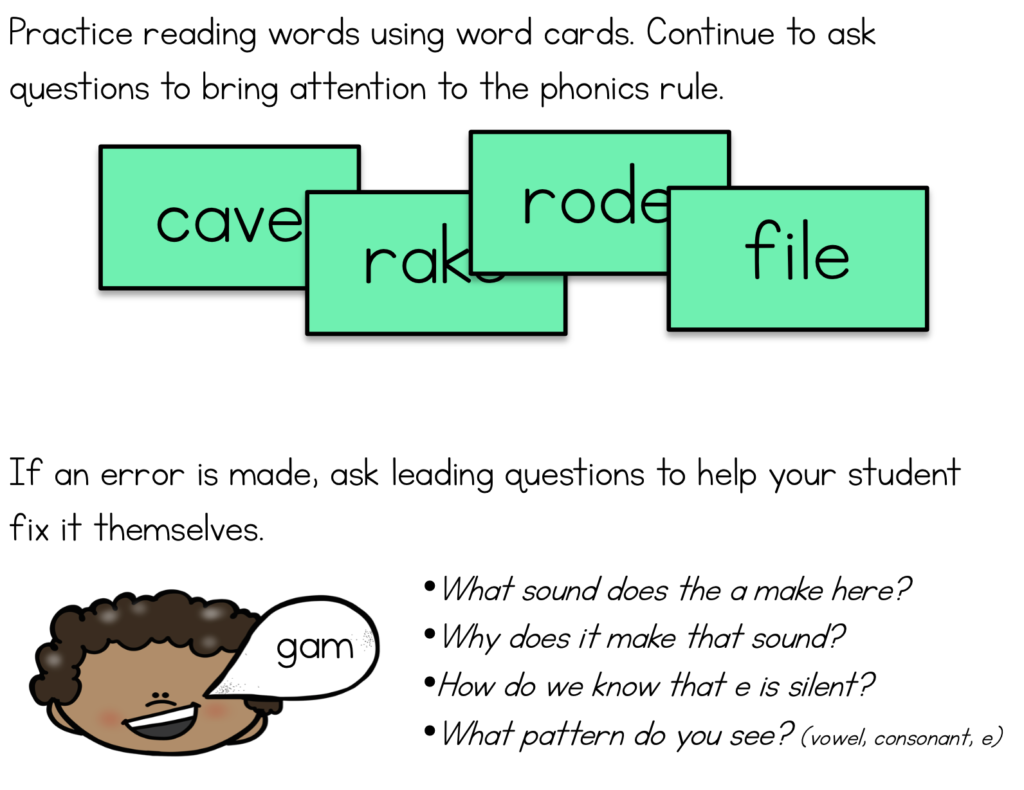
I like to use these cards first, then move on to regular word cards.
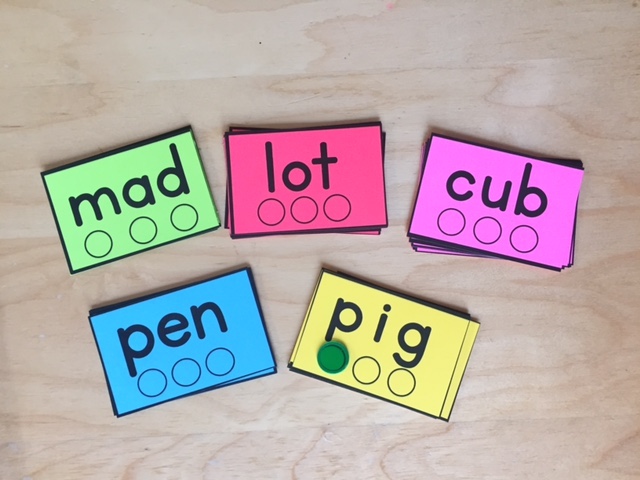
Word Sorts
Word can be sorted by word family or by rule. I would first do the rule to check for understanding. For example, if you are teaching silent e, students would read the card and sort words based on silent e or not silent e. As they sort, ask questions like, what do all those vowels say? What does the e do? How do you know it follows that rule (it has a vowel, then one consonant, then e).
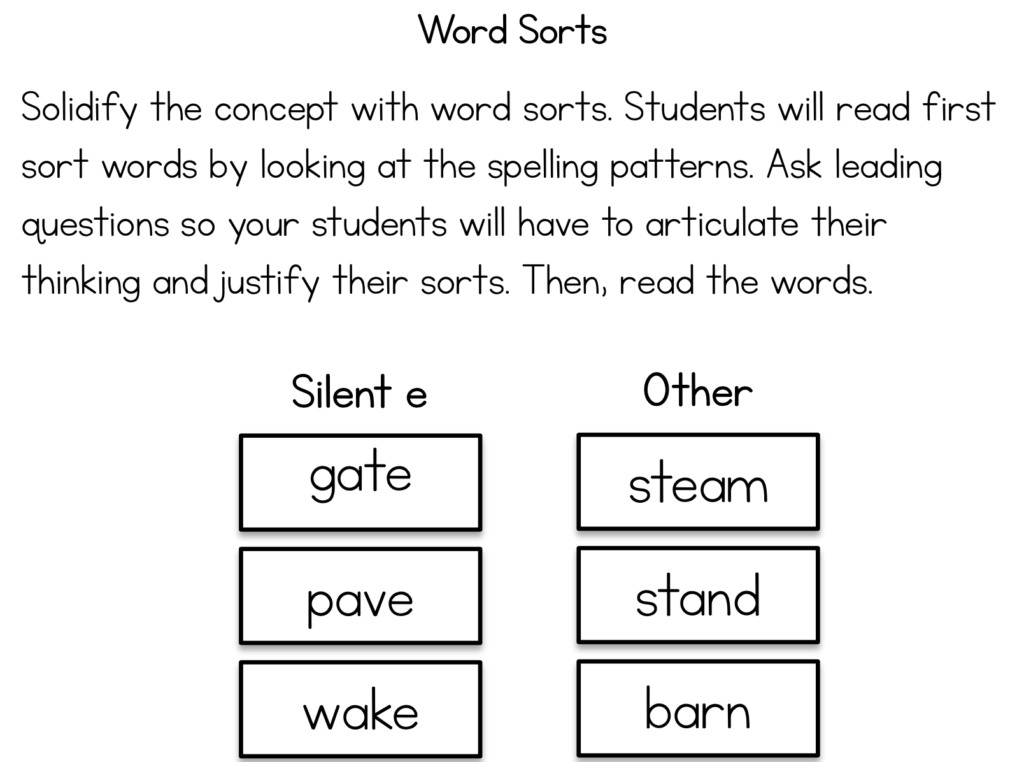
Below are pictures of sorts. Some require decoding while other require spelling or phonemic awareness.
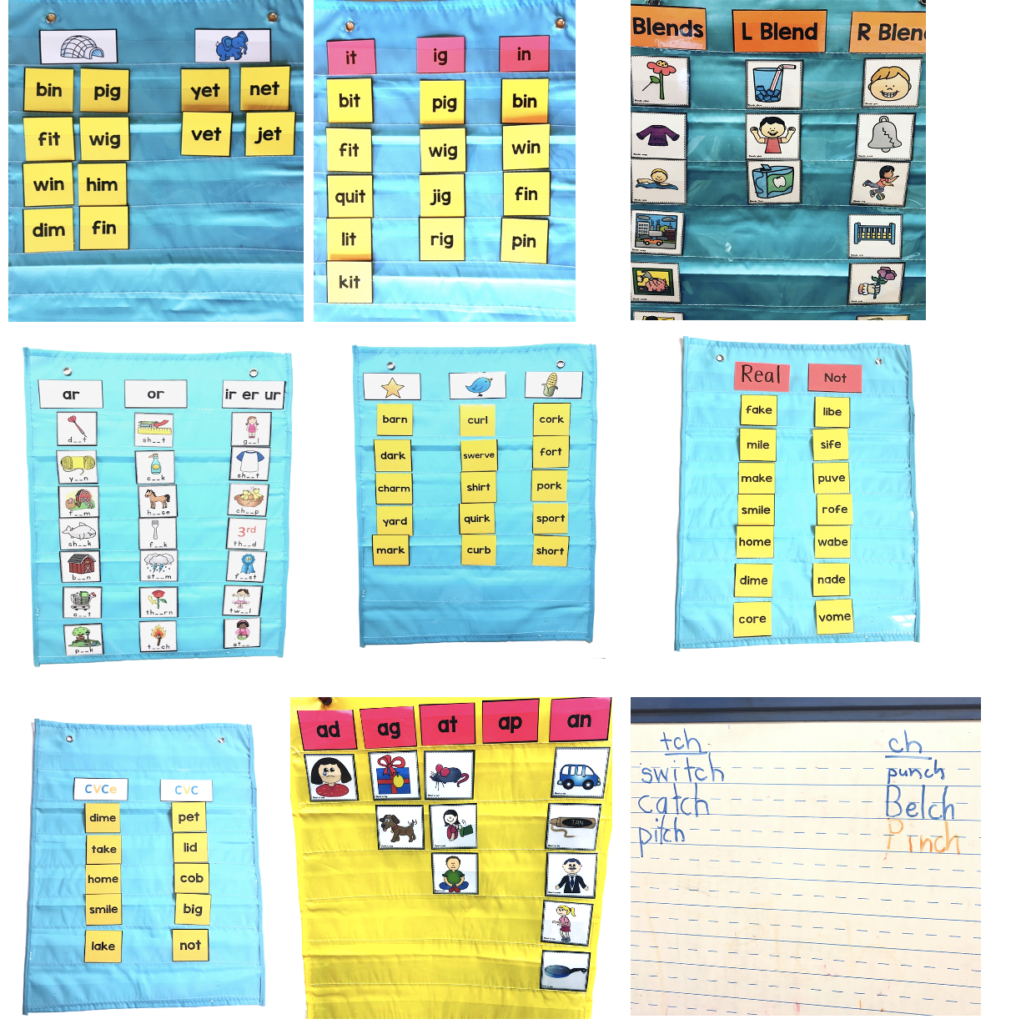
- When I first introduce a new phonics concept, I might simply do a yes/no sort. Students read the word and determine if it is short i or not. I know what you are thinking, they can just look and see the i. Remember this is a small group activity, so you are making sure they are still reading the words. This basically gives them a task to do so they are not just reading word cards for no reason. Plus every time they are reading another vowel card, you point out the difference in the sounds.
- Next, I may sort by word family or rule (for example, short i or short e.) As you move into blends, it could be r blend or l blend. Digraphs can be beginning or ending. There are so many possibilities. The key is that you giving these students opportunities to read several words with the phonics skill you are teaching and the phonics skills they have already learned in the context of a task.
- You can also do a sort to point out a letter pattern. The picture on the bottom left shows an example of this. Here, we are reading the words, then deciding which pattern it uses (CVC or VCe).
- I also like to do picture sorts to incorporate phonemic awareness. This is especially good for your struggling readers because they often have a hard time with phonemic awareness. I find this is also good for your ELL kids because they are listening for distinct sounds. For example, you can use picture cards with short a and short o. Say the picture word, then stretch the sounds and identify which vowel is used. You can then have students spell the word on their white boards.
- You can sort words by real or nonsense. Hold up the word card and have students read it. Then decide if it is real or not.
- The last picture above (bottom right) shows a sorting activity that doesn’t require reading. Instead the focus is spelling. This picture came from a lesson on -tch vs. -tch. For this activity, I would say a word, like “stitch”. Students would then write the word on their white boards. They would use their knowledge from the lesson to determine if they should use -tch or -ch. Next, I show them how I would spell it and why (I would draw sound boxes or use letter tiles to show that it should be -tch since a short vowel comes right before it). Finally, I would write it in the correct column.
If you are looking for cards like these, you can find them here:
Below are some more ideas to integrate decoding in a way that checks for student understanding.
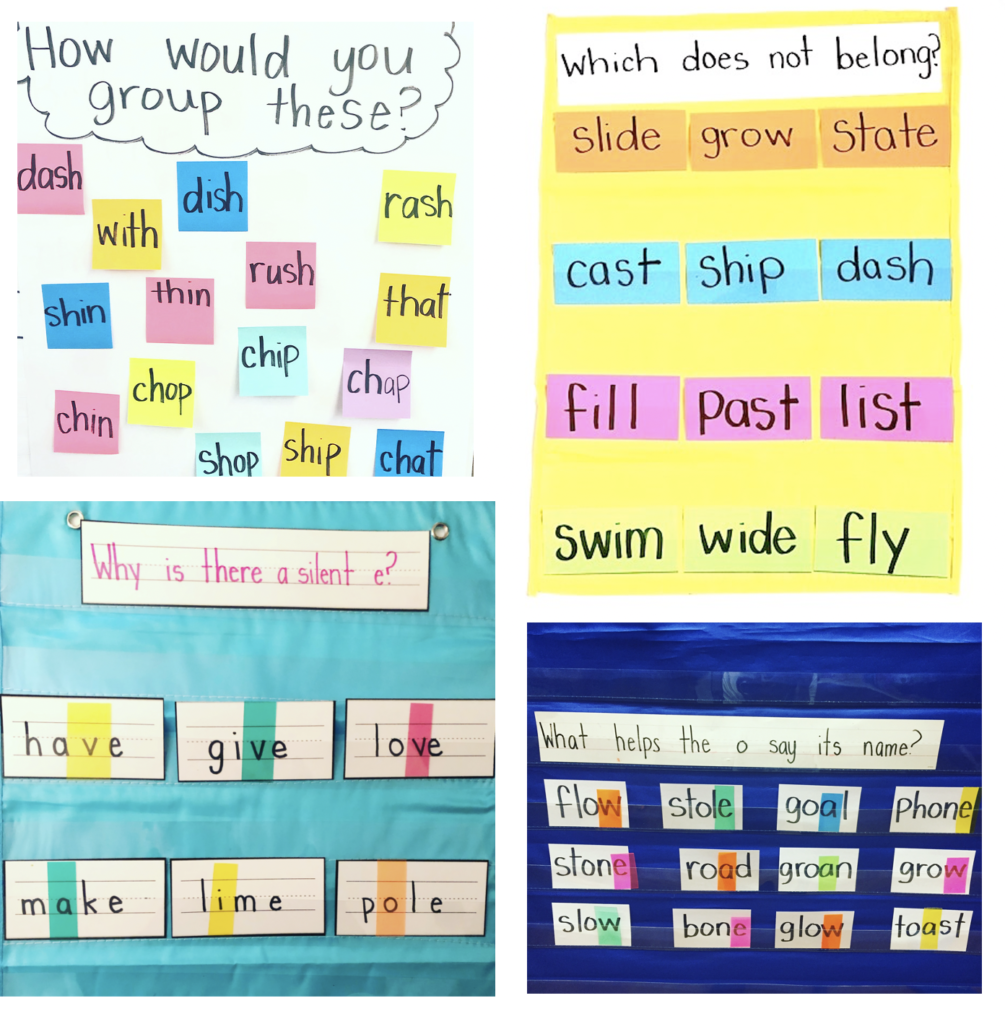
Word Lists
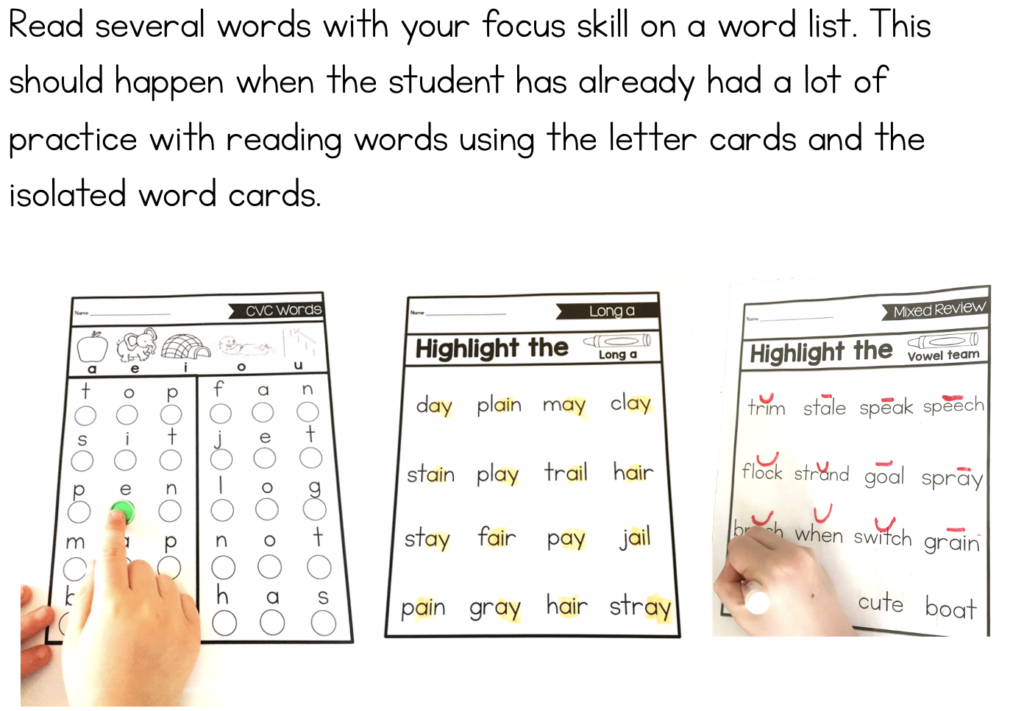
Here is another activity that my students love: Students take a circular math counter with a vowel on it. They fill each word with the vowel. Then you can try another vowel.

If you are looking for more resources to give your students extra practice with decoding words to help master each phonics skill, you may want to check out my Printable Phonics Intervention Packs.
So far, I’ve made CVC words, digraphs, blends, silent e, vowel teams, bossy r, and 2-syllable words (with open and closed syllables). Click HERE to get these for several phonics skills.
Phonics Intervention Step 9: Develop fluency with Decodable Texts
Reading and spelling words in isolation is just the first step but it is not enough on its own. They need practice reading these words in the context of a sentence, short passage, or book.
Decodoble Sentences
Below are ways my students practice reading at the sentence level:

- My kids LOVE Sentence Scramblers! They are perfect for practicing decoding and building fluency because your kids have read and reread the words in order to put the sentence in order. You can make your own by writing a decodable sentence on index cards (one word per index card). Mix up the words and have your students put the sentence in order. I now also have a digital Boom Card version. You can find these Phonetic Sentence Scrambles here.
- I have several resources for sentence building. One is connecting phrases (above left) and the other is building a sentence word by word (above right).
- You can also simply write decodable sentences on paper or a white board and have your students read them. I have a whole set of ready-made sentences (shown above in the middle) that you can find here.
- I also made a Sentence Spin with decodable sentences:
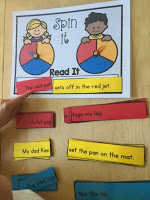
Decodable Books and Reading Passages
Over the years, the hardest thing to find has been decodable texts! I made some of my own, but there are now several more decodable book options out there.
My favorite are from PhonicBooks. They have the best decodable books! They are based in the UK but PDX Reading Specialist is a US distributer. Click here to see more.
Phonetically-controlled texts are so important for our very beginning readers and for our struggling readers. These texts give them an opportunity to apply the phonics skills they’ve learned without having to worry about guessing or seeing tons of words they don’t know. They can be successful with these texts, all the while strengthening the those pathways in their brain. (To read more about reading and the brain, click HERE to see an old post with tons of information.)
The goal of reading ultimately is meaning. Obviously we want to get them out of phonetic readers so they can move on to more interesting books. These phonetically-controlled books are a means to an end. They are not the end goal. But, I have learned over the years that they are necessary.
Once I know my students have a strong phonics foundation and automaticity with phonics skills, I am confident that they will be successful with other books. They will be ready to apply strategies effectively, as opposed to just guessing as our struggling readers tend to do.
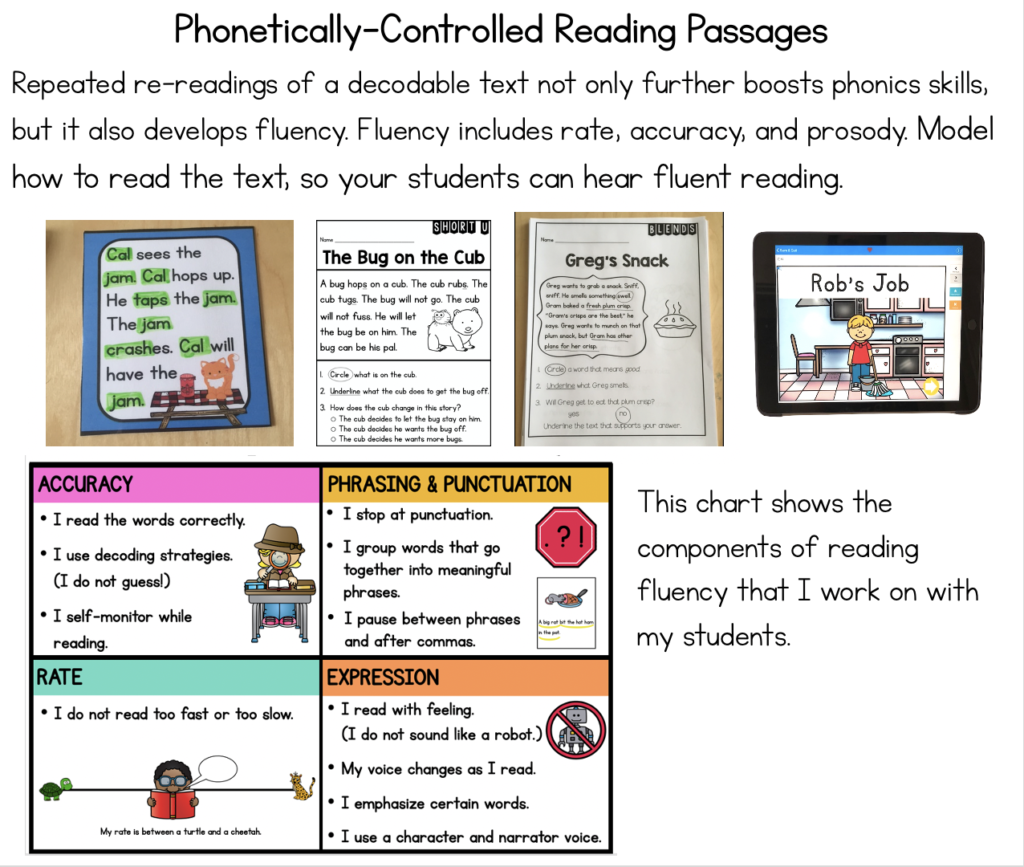
If you are looking for phonetically controlled printables or story cards, I have short stories with just CVC words, consonant blends (with short vowels), silent e, and vowel pairs.
- You can find just the reading passages for short vowels HERE.
- You can find the reading passages for blends HERE.
- You can find reading passages for long vowels here.
- I also have a set of 10 short books (printable and digital boom cards) for CVC words. You can find those here.
Encoding/ Spelling
Another important component to phonics instruction is always including spelling. This is NOT your tradition spelling where you memorize a list of words for a test. By spelling, I mean applying the rule directly to several words. For more about spelling and English orthography, click HERE.
Remember when you introduce a phonics skill, you are beginning with the auditory and segmenting the sounds in words. This is encoding (spelling). One mistake I made for a long time is not doing as much encoding as decoding. I promise you will see results if you start emphasizing spelling as much as reading.
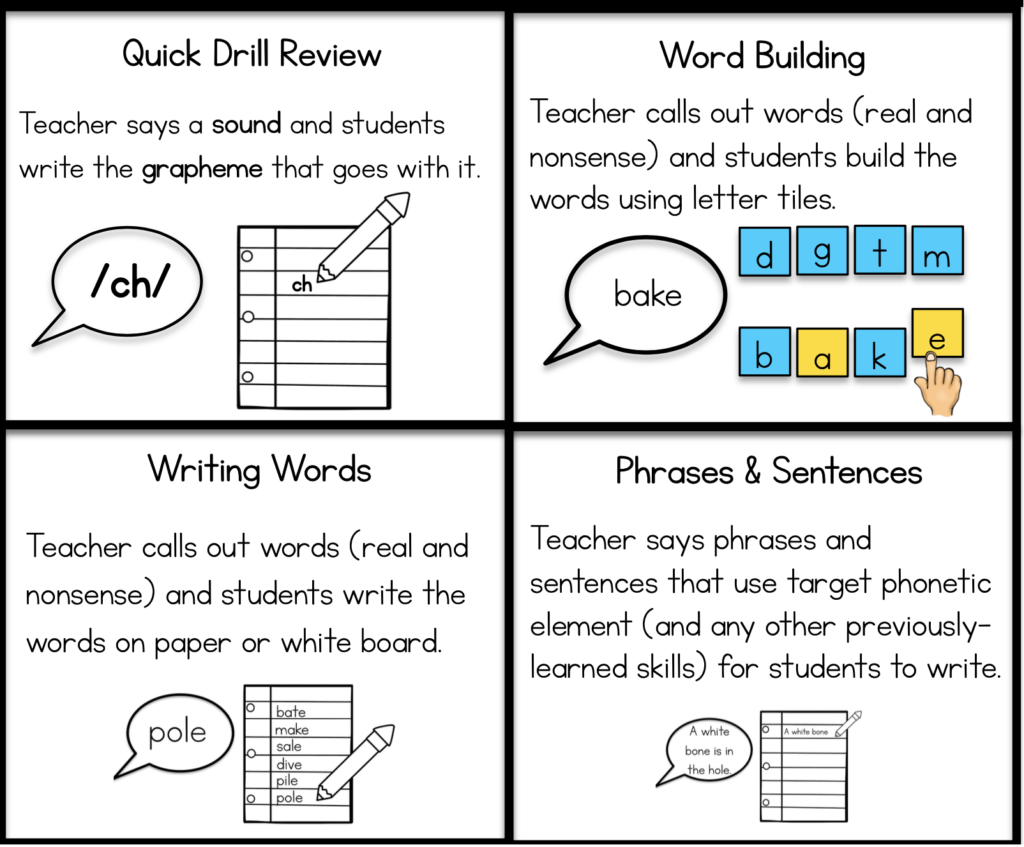
- Include real and nonsense words.
- Call out a word and watch your students spell it.
- Listen to how they are orally segmenting the word before they grab the tiles. This is a great informal assessment!
- Guide them with leading questions if they make mistakes, instead of telling them the correct spelling.
- When learning a phonetic rule, it is best to encode vs. try to write it from memory like with most spelling tests. Have your students “tap the sounds” with a finger. Then write the graphemes to correspond to each sound. (As you introduce morphology, you will teach your students how that affects encoding.)
- Finger spelling is a powerful tool: Each finger represents one sound. Students “tap out” the sounds before writing.
- Teacher: ”math”
- Student: “math /m/ /a/ /th/” Put up a new finger for each sound as if you are counting.
- Finger spelling is a powerful tool: Each finger represents one sound. Students “tap out” the sounds before writing.
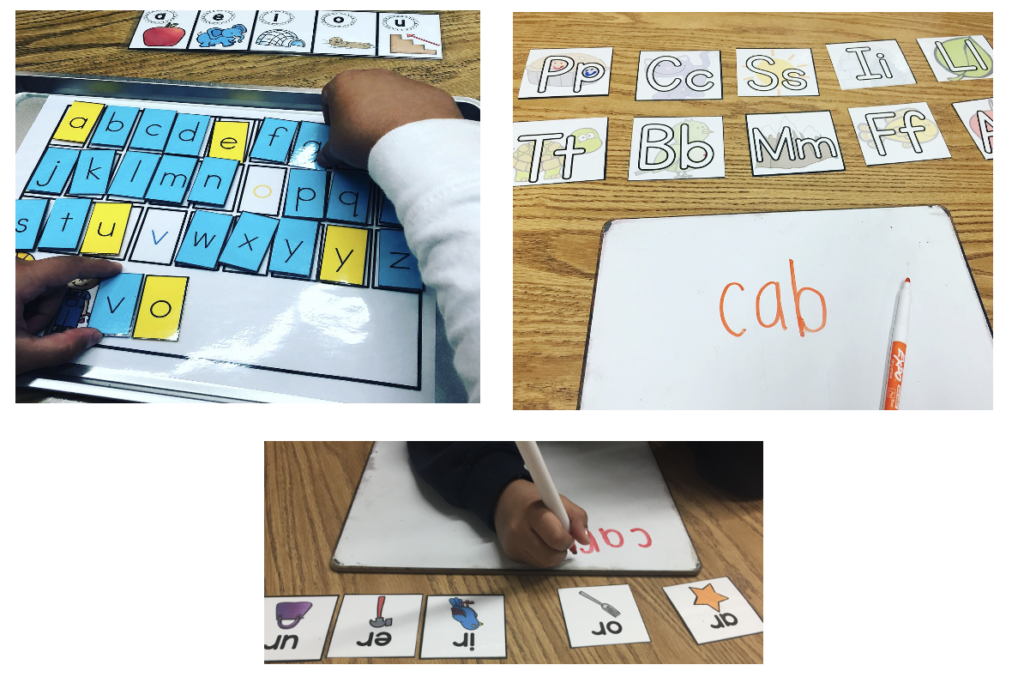
I like using these little cookie sheet boards for my students to build words on in the beginning (before the words get too big.) This is super convenient. I have six of these and they stack right on top of each other. The magnetic dots hold the letters in place.
To make it multi-sensory, say the sounds as your trace on the table or tap out the sounds in the words. Even writing the letters as you make the sounds counts as multi-sensory!
Sound Boxes:
A resource that I use quite often are my sound boxes. I LOVE sound boxes, especially early on.
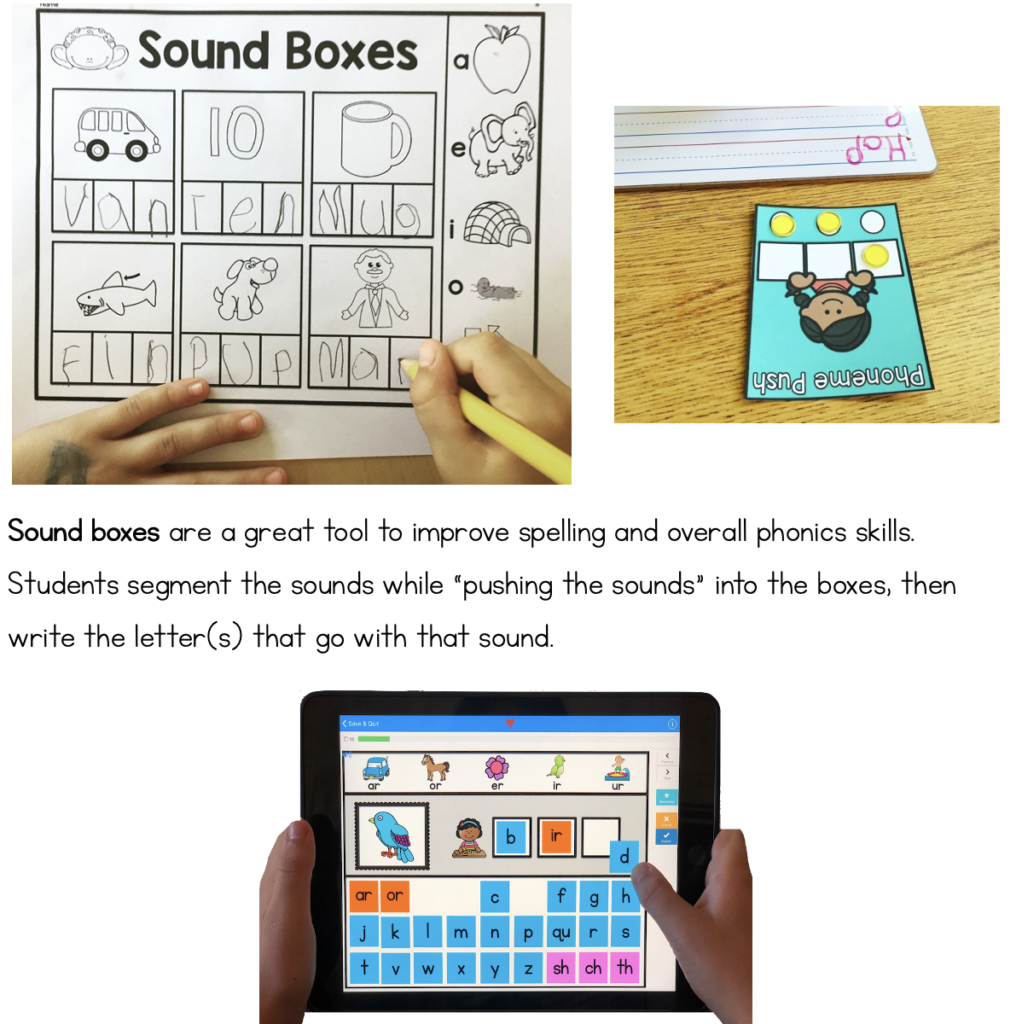
- Above (right) is a picture of a sound box that I use when I do not have picture cards. I call out a word and they “push the sounds” first, then write the corresponding letters.
- Above (left): I also made a pack of sound boxes with pictures that I use a lot. I have a “printable” version and cards to laminate. With the laminated cards, I show the students the card. Each student has 3 colored circular counters. We all “push” the sounds at the same time (I will push the sounds on the actual card or have students take turns with the actual card.) Then, we all write the corresponding sounds. You can find ready-made sound boxes here.
- Update: I now have digital sound boxes for several phonetic elements. You can find all of my Word Building Boom Decks here.
Sound boxes should be done very early on, along with early decoding. Encoding (spelling words) should go hand in hand with decoding. Sound boxes can be used in kindergarten without the use of letters. The focus is on breaking up the sounds in the words in this case. Later, you connect it to letters.
Storage
I’ve tried it all and this is my favorite way to store my materials. I use this storage box (found here) and for bigger items I use these long flat bins.
Small Group Lesson Structure
This is a lesson plan template that you may want to try out. This can be used for one-on-one tutoring or a small group.
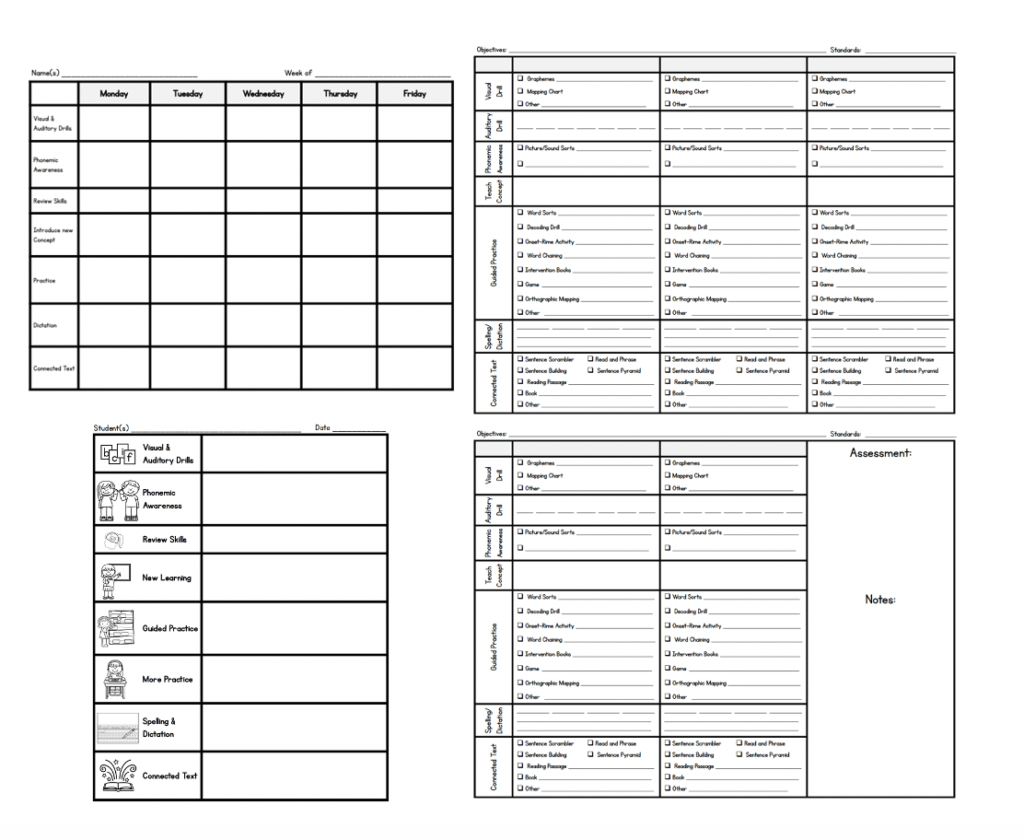
These are some ideas for things that may go in each section:
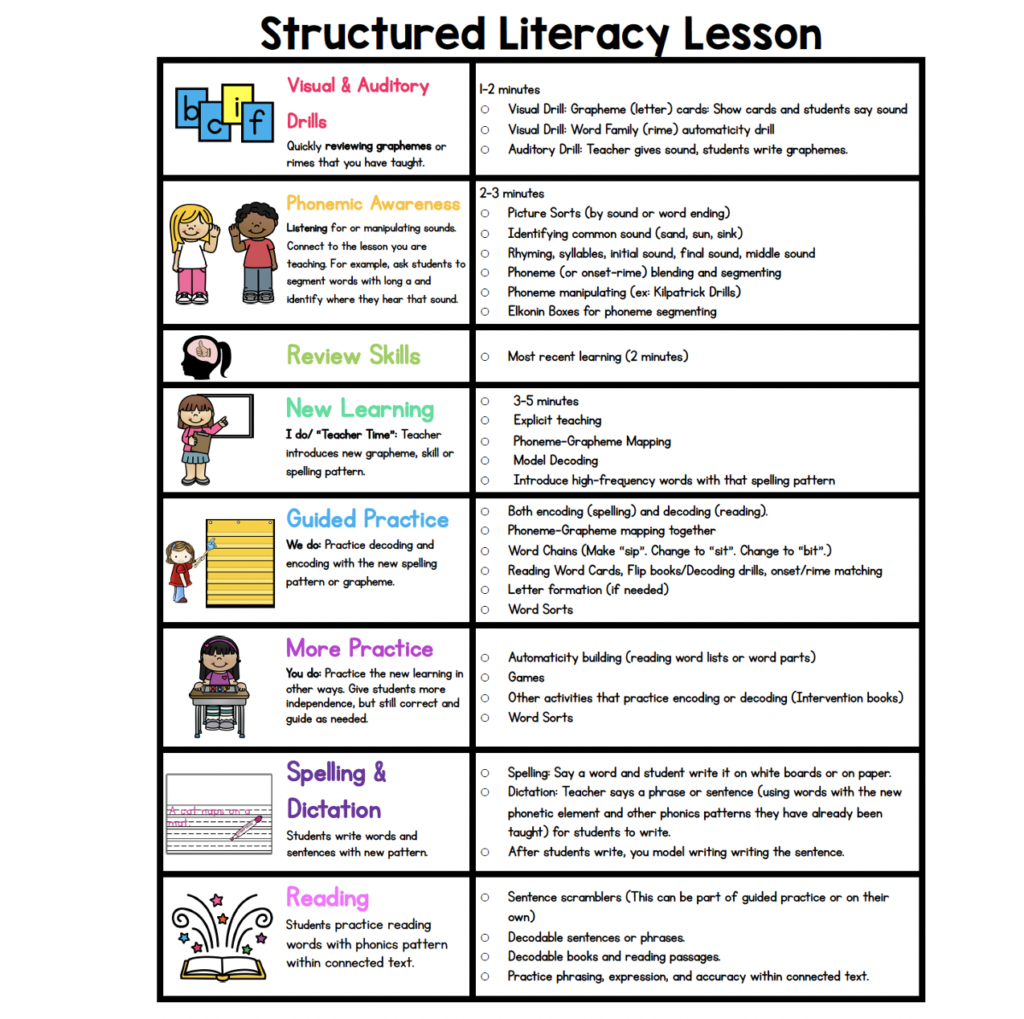
In a small group setting, you wouldn’t necessarily be able to get to all of those components every day, unless you were given a good chunk of time. With one-on-one tutoring, I do get to all of those parts and it is so effective. With my small intervention groups in school, I pick and choose each day, depending on time. The picture above has a little explanation (also included in the FREE download.) If you want more free downloads like this one, you may want to join my mailing list! Click HERE if you are interested in getting more resources and information like this.
I hope this post is helpful! Please don’t hesitate to email me if you have any questions.
To download this whole blog post with clickable links, click here: Explicit Systematic Phonics Intervention ebook.
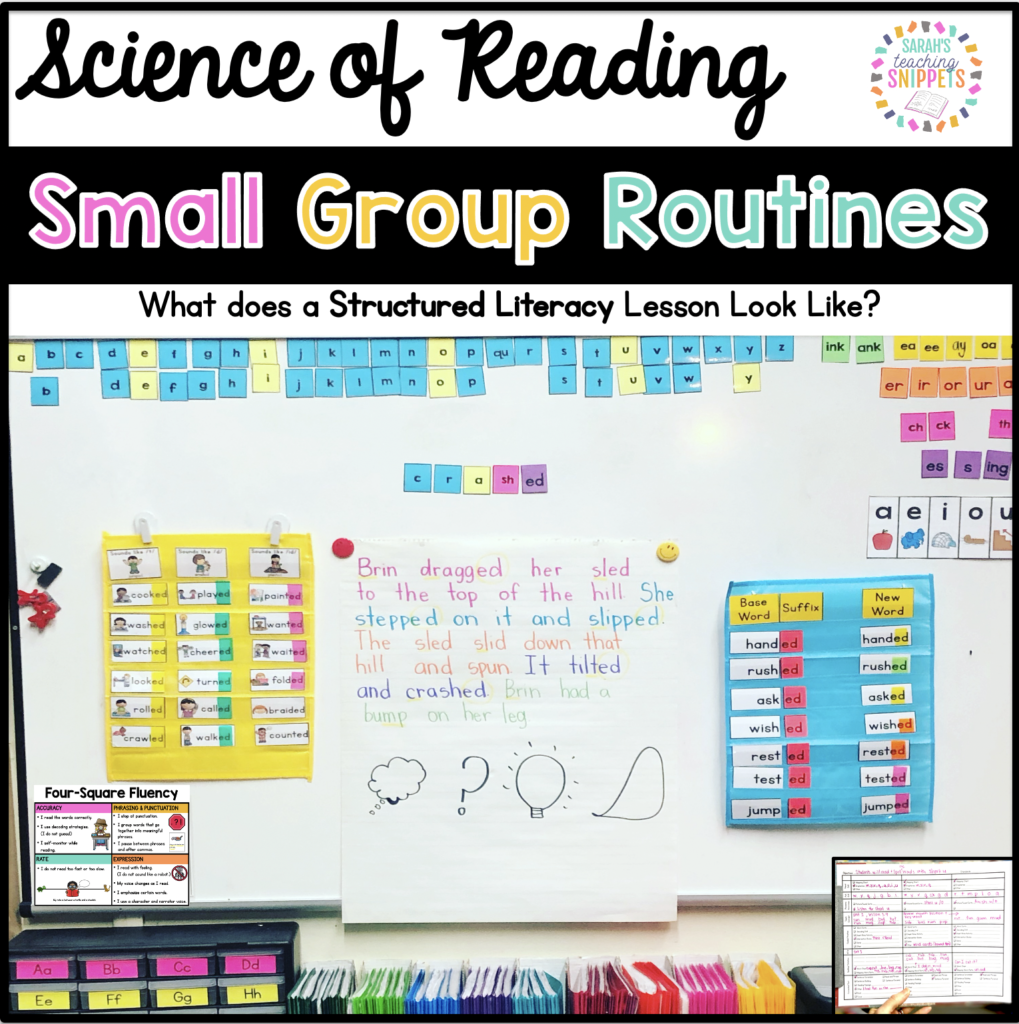
Related Blog Posts
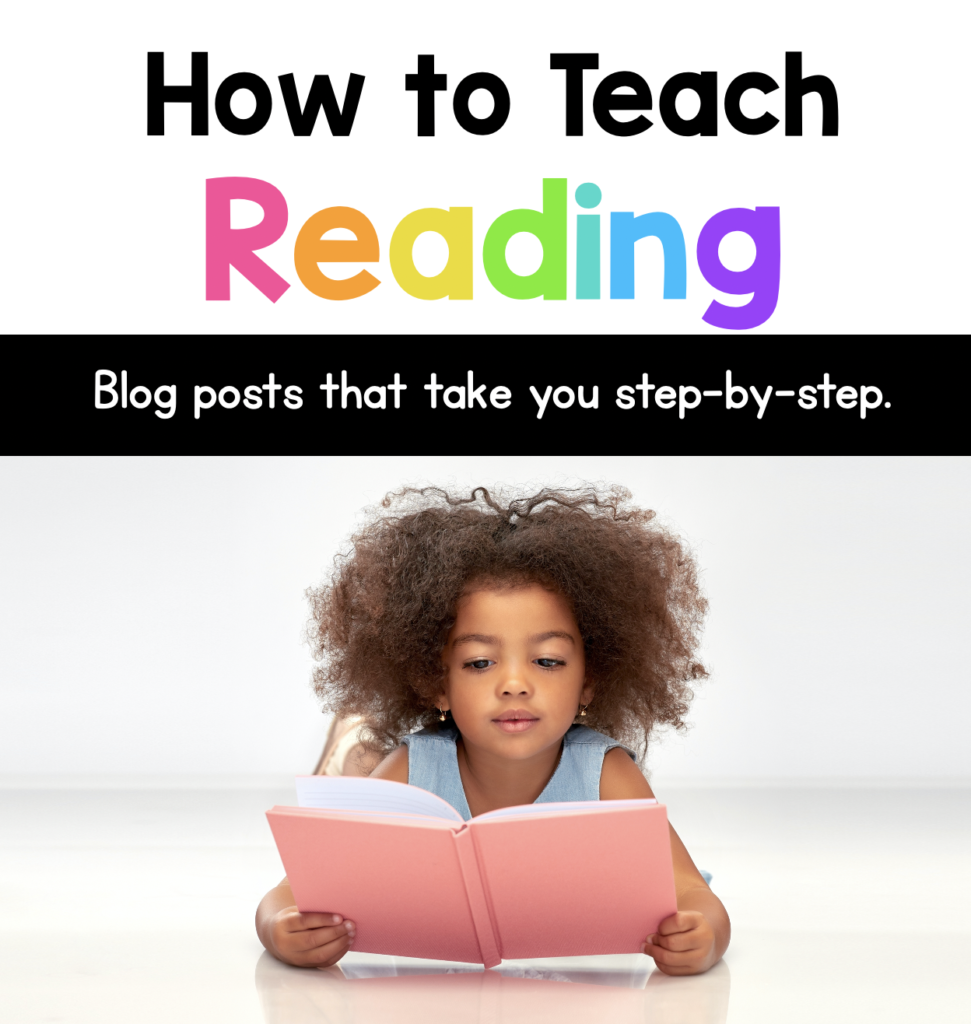

Resources for Phonics Intervention
Click here to see my phonics resources organized in the order that I would teach them.
SaveSaveSaveSave
